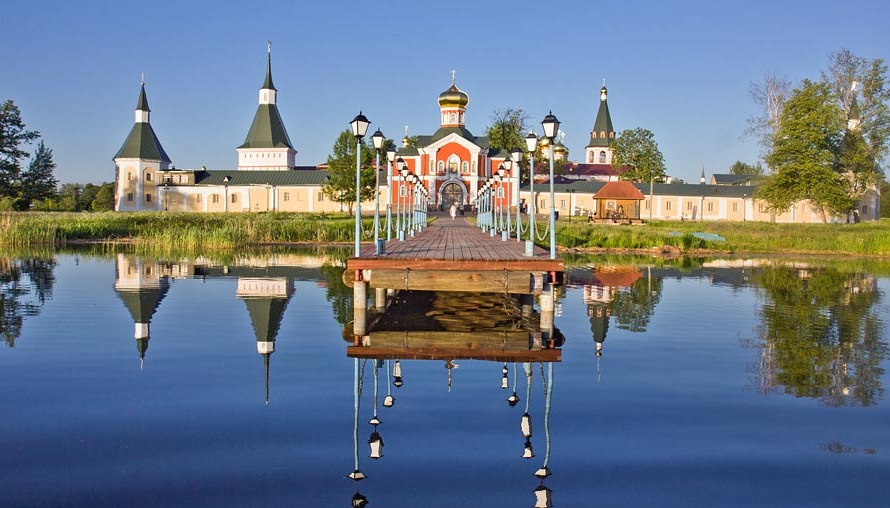The hotel "Valday" is situated in National Park in the heart of central Russia, 400 km North-West from Moscow and 300 km South-East from St.-Petersburg. It occupies two covered by forest semi-islands of Lake Uzhin. A trip to this hotel includes a 2-hour voyage by fast train either from Moscow or from St.-Petersburg, followed by a 30-minute ride by bus/taxi. The hotel is separated from the Valday town by the large freshwater Lake Valday, which gave its name to the whole area. Some 150 km to the east of the hotel there is an ancient city of Velikiy Novgorod, which we are planning to visit during the conference. Large distance from big cities and highways not only ensures fresh air and clean water in the Valdaysky district but also provides an opportunity to appreciate the peaceful beauty of Russian nature.

Lake Valday
Lake Valday is located in the Valdaysky District of the Novgorod Region, in the middle of the Valday Hills and right in the centre of Valdaysky National Park, which is a part of the UNESCO Biosphere Reserve. This is one of the largest lakes in the Novgorod Region: its area is 19.7 square kilometres (7.6 sq mi), and the area of its basin is 97.2 square kilometres (37.5 sq mi). The depth of this lake is 12 metres (39 ft) in average and 60 metres (200 ft) at the deepest point. It is connected to a smaller lake, Lake Uzhin, by an anabranch. The lake freezes up in early December and stays icebound until early May.
UNESCO Biosphere Reserve is comprised of 76 lakes scattered throughout the landscapes of the Valday Hills, the only elevations on the vast plain between Moscow and St. Petersburg. In this region, several biggest European rivers originate, including Volga, Dnieper and Daugava. Its forests of birch, spruce and pine are populated by a vast variety of fauna, including moose and brown bears. Since the 18th century this area has been a place of attraction among Russian elites, who have chosen this site for their summer estates.
Valday contains 43 cultural heritage monuments of federal significance and, in addition, 74 objects classified as a cultural and historical heritage of local significance. The federal monuments are, for instance, the ensemble of Iversky Monastery and the Presentation Church.


Valday Town
Valday village was first mentioned in chronicles in 1495 as a part of the Novgorod Republic. The growth of Valday was facilitated by the construction of the road, connecting Novgorod with Central Russia, and by the foundation of the Iversky Monastery in 1653, which had become a major cultural centre. The famous monastery is still may be found on one of the islands in Lake Valday. In 1770 the village developed into a town, which has become a trade and craft centre on the way from St. Petersburg to Moscow. From the end of the 18th century and to the present day Valday is famous for its casting bells craftsmen. Since 1995 the town has been hosting a Museum of bells, located in the old building of 1793, where the bells and bell craftsmanship of different epochs are displayed.
The most popular touristic sights in Valday include the Church of the Apostles Peter and Paul (19th century), Holy Trinity Cathedral (1744) in the heart of the Cathedral square, and the Church of the Blessed Virgin (1762).



Velikiy Novgorod
Velikiy Novgorod is one of the most ancient cities of the north-western part of Russia, near the site where the Volkhov river takes its waters from Lake Ilmen. Novgorod emerged as a political centre of the Slavic and Fino-Ugric tribes in the mid-9th century and became a medieval town in the middle of the 10th century.
The history of Novgorod is closely related to that of Russia. During medieval times, when the statehood of Russia was in its cradle, the citizens of Novgorod invited Scandinavian prince Rurik to establish law and order, giving birth to the dynasty that ruled over all Russian lands for more than 750 years.
For centuries Novgorod was a political centre of vast territories, ranging from the Baltic lands and Finland to the west and the northern Urals to the east. During that time it was one of the biggest trade centres on the Baltic-Volga commercial route, which connected northern Europe with Asia from the middle of 8th century.
Novgorod was also one of Russia's major centres of literacy and book production. In the 11th century, by the will of Yaroslav The Wise, the first school for 300 children was established in Novgorod. Medieval Novgorod was one of the greatest art centres of Europe as well: its architectural traditions, school of icon-painting, jeweller's and decorative art are famous all over the world.




